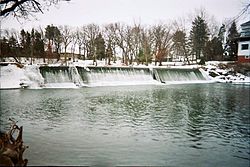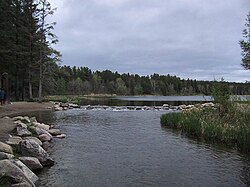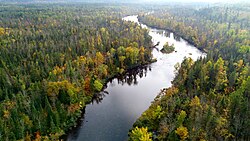- Topographic map of Minnesota streams, lakes and rivers in blue
- Bois de Sioux River below Lake Traverse dam. Roberts County, South Dakota is at left, and Traverse County, Minnesota is at right.
- Cobb River in Blue Earth County
- Embarrass River in Winter
- Le Sueur River near Red Jacket trail
- Minnesota River Mendota Heights bridge
- Mississippi River source at Lake Itasca
- Mississippi River and Minnesota River confluence near Fort Snelling State Park
- Mississippi River at St. Anthony Falls in Minneapolis
- Pigeon River High Falls at Grand Portage State Park
- Red River of the North as viewed from Fargo, North Dakota
- St. Croix River viewed in Wisconsin
- Vermilion River in St. Louis County
| Longest streams of Minnesota | |
|---|---|
 |
Out of the 6,564 streams that flow through the U.S. State of Minnesota, there are 114 streams that are at least 30 miles long. The second longest river in the United States, the Mississippi River, originates in Minnesota before flowing south to the Gulf of Mexico. The longest river entirely within the state of Minnesota is the Minnesota River. Other rivers over 200 miles long include the Red River of the North, Des Moines River, Cedar River, Wapsipinicon River, Little Sioux River, and Roseau River. [1] [2]
Contents
- Table of longest streams
- Map of Minnesota streams and lakes
- Gallery
- See also
- Notes
- References
- General references
Sections of several of the longest rivers define sections of the Minnesota border. [3] The Red River of the North forms the border with North Dakota to the west. The Bois de Sioux River forms the border with South Dakota to the west. The Mississippi River, St. Croix River, and the St. Louis River form the border with Wisconsin to the east. The Rainy River and Pigeon River form the border with Ontario, Canada to the north.
Minnesota contains three major drainage basins with waters from Minnesota rivers flowing south, north, or east. [1] These major drainage basins meet in a triple divide point called the Hill of Three Waters, just north of Hibbing, Minnesota. [4]
- The Mississippi River drains south to the Gulf of Mexico. In Minnesota, this basin is traditionally subdivided into the following major sub-basins:
- Headwaters of the Mississippi River (above St. Paul)
- Minnesota River drainage basin (17,000 sq mi (44,000 km2))
- St. Croix River drainage basin (7,700 sq mi (20,000 km2))
- Lower portion of the Upper Mississippi River (Below St. Paul). Some of these rivers discharge into the Mississippi within the borders of Minnesota, and some farther south, including the Des Moines River, the Cedar / Iowa River, and others
- Tributaries of the Missouri River also have drainage basins in far southwest Minnesota
- Water flows to the north in the Hudson Bay/Arctic drainage basin (3,861,400 sq mi (10,001,000 km2)), which includes the Red River of the North drainage basin (111,004 sq mi (287,500 km2)) and Lake of the Woods drainage basin (13,805 sq mi (35,750 km2))—of which 7,285 sq mi (18,870 km2) is in Minnesota.
- The Great Lakes Basin to the east includes the Lake Superior drainage basin in Minnesota and Wisconsin (49,300 sq mi (128,000 km2)). [5] Minnesota water flows eastward through the Great Lakes to the Atlantic Ocean.


























